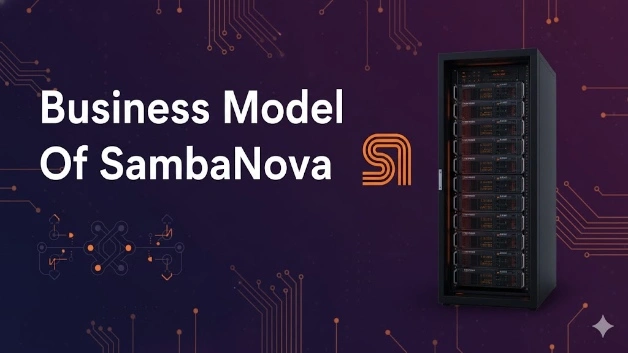| Category | Details |
|---|---|
| How SambaNova Started | Business Model Of SambaNova: SambaNova was Founded in 2017 by Rodrigo Liang (CEO), Kunle Olukotun (Stanford professor pioneering multicore processors), and Christopher Ré (Stanford machine learning researcher). The Palo Alto-based startup emerged from Stanford research identifying data movement as the critical bottleneck in AI computing performance. SambaNova Raised $1.1 billion in venture capital reaching $5 billion valuation in 2021, backed by Walden International, SoftBank Vision Fund, BlackRock, and GIC. Developed proprietary Reconfigurable Dataflow Unit (RDU) processors featuring three-tier memory architecture integrating SRAM, HBM, and DRAM to eliminate data movement bottlenecks plaguing GPU systems. The SN40L chip manufactured on TSMC’s 5nm process contains 102 billion transistors, claiming 6x faster training and 10x inference improvements versus Nvidia’s A100 GPUs on specific workloads. |
| Present Condition of SambaNova | SambaNova is Currently in preliminary acquisition discussions with Intel Corporation, likely valued below previous $5 billion peak after struggling to secure new funding rounds. Serves U.S. Department of Energy laboratories, OTP Bank (Hungary’s largest commercial bank), Analog Devices, and numerous Fortune 500 enterprises. Technology supports models twice the size of advanced ChatGPT versions while running 5 trillion parameter models with 256,000+ sequence lengths on single system nodes. Despite technological validation through VentureBeat “Coolest Technology” awards and customer-reported performance tripling,SambaNova management explored sale options after failing to complete fundraising—demonstrating market reality where architectural superiority alone cannot overcome Nvidia’s ecosystem dominance and CUDA software lock-in. |
| Future of SambaNova and Industry | The global AI chip market valued at $123.16 billion in 2024 projects explosive growth to $311.58 billion by 2029 (20.4% CAGR). Data center semiconductors projected to comprise over 50% of total semiconductor market by 2030, with AI training representing $400 billion market yet inference workloads serving billions of daily queries representing larger addressable market. Custom ASIC-type chips project highest growth rates exceeding 31.70% CAGR through 2029 due to efficiency advantages. However, Jon Peddie Research predicts market consolidating to approximately 25 survivors by 2030 from hundreds of current startups. GPU market projected $342 billion by 2030 yet faces pressure from alternatives including Google’s TPUs (13.1% market share), edge inference accelerators ($7.8 billion in 2025 revenue), and specialized processors. McKinsey estimates $6.7 trillion in data center capital expenditures through 2030, with majority funding AI chip systems. Under Intel ownership, technology would integrate into broader product portfolio targeting inference market where power efficiency and cost economics favor alternative architectures. |
| Opportunities for Young Entrepreneurs | AI inference workloads—comprising 90%+ of production deployments—create opportunities for specialized architectures optimizing latency, throughput, and power efficiency rather than raw training speed. Capital requirements and ecosystem maturity barriers push technical innovation toward acquisition targets rather than independent scaling, creating exit opportunities for foundational technology builders. Sovereign AI computing requirements driven by CHIPS Act ($280 billion domestic semiconductor support) and export restrictions create market gaps for U.S.-based alternatives to Chinese manufacturing. Power consumption challenges—GPU systems requiring liquid cooling and 40+ kilowatts versus air-cooled alternatives consuming 10 kilowatts—enable deployment in existing data center infrastructure without facility upgrades. Full-stack integration delivering hardware, software, and pre-trained models as managed services eliminates customer complexity, enabling enterprises without internal AI expertise to deploy production systems within days. 99% of world’s 2,000 largest companies remain in exploratory phases without production AI deployments, representing massive addressable market for solutions offering better economics than Nvidia’s premium pricing. |
| Market Share of SambaNova | Operating in highly concentrated AI chip market where Nvidia dominates with 87% market share ($96 billion in 2025 AI chip revenue) and consumes 77% of AI-designated wafer supply (535,000 wafers in 2025). Intel captures estimated $500 million in 2025 AI revenue (<1% share) versus AMD’s $4.5 billion. The company competes in merchant AI accelerator segment alongside Cerebras, Groq, and others, collectively holding minimal share against GPU incumbents and cloud giant custom silicon (Google TPUs, Amazon Trainium, Microsoft Maia). Government customer base including Department of Energy laboratories provides stable revenue but limited scale compared to hyperscaler deployments. Down-round acquisition discussions reflect market position challenges despite technological advantages. |
| MOAT (Competitive Advantage) | Proprietary Reconfigurable Dataflow Unit (RDU) architecture fundamentally different from GPU computing paradigm. Three-tier memory integration (SRAM, HBM, DRAM) eliminates data movement bottlenecks through intelligent compiler software dividing computational loads across memory tiers—addressing bottleneck co-founder Olukotun identifies as “critical to high-performance inference.” System handles multiple large language models concurrently while switching between them instantly, capabilities claimed unavailable on competing platforms. Power efficiency consuming average 10 kilowatts per rack versus GPU systems requiring 40+ kilowatts enables deployment in air-cooled data centers without infrastructure upgrades. Full-stack platform delivering complete solutions (hardware, software, pre-trained models) as managed services or on-premises installations reduces customer integration complexity. Performance validation through enterprise deployments and national laboratory customers provides credibility. However, CUDA ecosystem advantages and Nvidia’s decade-long software investment create switching costs limiting MOAT effectiveness. |
| How SambaNova Makes Money | Hardware sales of RDU processors and complete system installations to enterprise customers and government agencies. Managed AI services providing cloud-based access to computing infrastructure without capital expenditures. On-premises deployments for customers requiring data sovereignty and private model training/inference. Professional services supporting system integration, model optimization, and workflow customization. Revenue from Department of Energy laboratories, Fortune 500 enterprises (OTP Bank, Analog Devices), and commercial customers deploying private LLM infrastructure. Potential licensing of dataflow architecture intellectual property and compiler technology to partners. Under Intel acquisition, technology would integrate into broader product portfolio generating revenue through data center sales channels, government contracts leveraging sovereign capability positioning, and inference-optimized offerings competing against Nvidia’s training-focused GPUs in cost-sensitive enterprise deployments where power efficiency and operating economics determine total cost of ownership. |
I’m Araib Khan, an author at Startups Union, where I share insights on entrepreneurship, innovation, and business growth. This role helps me enhance my credibility, connect with professionals, and contribute to impactful ideas within the global startup ecosystem.




